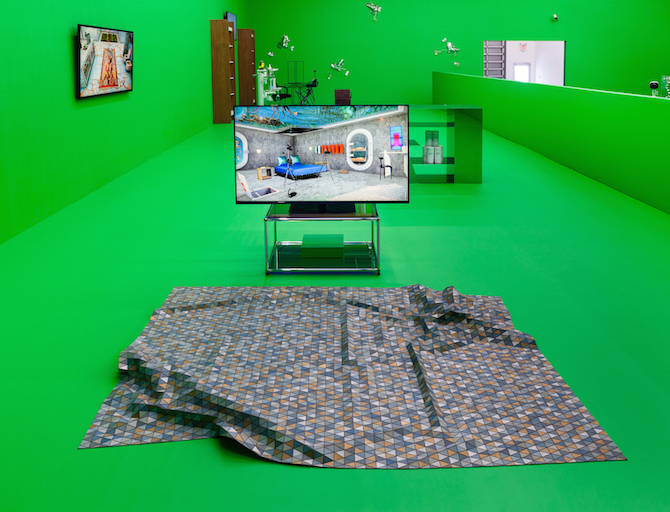Search
To search for an exact match, type the word or phrase you want in quotation marks.
A*DESK has been offering since 2002 contents about criticism and contemporary art. A*DESK has become consolidated thanks to all those who have believed in the project, all those who have followed us, debating, participating and collaborating. Many people have collaborated with A*DESK, and continue to do so. Their efforts, knowledge and belief in the project are what make it grow internationally. At A*DESK we have also generated work for over one hundred professionals in culture, from small collaborations with reviews and classes, to more prolonged and intense collaborations.
At A*DESK we believe in the need for free and universal access to culture and knowledge. We want to carry on being independent, remaining open to more ideas and opinions. If you believe in A*DESK, we need your backing to be able to continue. You can now participate in the project by supporting it. You can choose how much you want to contribute to the project.
You can decide how much you want to bring to the project.

One of the images that will be left engraved from the New Museum’s Triennial this year that’s ending belongs to The Island, the shower-kitchen unit designed by DIS and Mike Meiré. The luxuriously finished recipient-artifact designed for a stylish being. A clothed model dressed relaxes under streams of water while someone stirs vegetables on the hob. The public received it with astonishment, fascinated and perturbed by its brazen hypnotic effrontery.
The correspondence between interior space and subjectivity extends to encompass architecture and body, design and gesture, domestic space and social codes. From the Latin domus derives the garden-house, property understood as domination and exploitation of material resources and humans, for a élite embodied by the patres (master) and the domina (mistress). Patrimony-possession differentiated from matrimony-reproduction. The Lares with their gaze watch over what will become of the house. The construction of the domestic space according to the coordinates of class and power are directed by a human planning that extends beyond the dimension of the home to include the metropolis. The cardus and the decumanus of the military camp applied to the colonies, the classification by guilds, and the cheap insulae for the tenants packed in together in the Roman Empire. In Sex and Terror (2005), Pascal Quignard dissected the Roman villa as a mnemonic structure with which to practice memory and memorization, each room, an episode of life, each door and wall, a model for oral literature. Rooted in the remote villa is the ideal of autonomous living, the origin of the holiday impulse, the assuming of another life in another place, being different in the summer house.
The domestication of the surroundings, the selection and control of genetics (animal-vegetable-human), and the systematic elimination of any glimmer of alterity, resistance, or subversion against the oligopoly of morality, wealth, and knowledge marks the ideological planning of development. Manfredo Tafuri in Architecture and Utopia. Design and Capitalist Development (1973), surveys the architecture of the Enlightenment situating it in equilibrium between a social instrument and science of sensations, between a study focused on typologies and ex novo invention of a new public reality. On the one hand the transmission of forms, on the other, the utopian vision of a total, Unitarian reformulation. Two impulses, which merge in the production of buildings and the ordering of space, exemplified by Le Corbusier with the Pavillon de l’Esperit Nouveau, a project revisited in a recent exhibition at the Swiss Institute of New York. The principles of the house-machine and the reciprocity between products and standardized lives that Le Corbusier proposed in 1925, serve now 90 years later, to present new synthetic materials and situate the domestic in a desert of surveillance and evasion thanks to the chrome green.

The domestic is the domination of the savage, just as the wild ruptures the domestic, understood as habit/at/o (dwelling-behavior). When in 1938 Le Corbusier invades E.1027, the summer house designed by Eileen Gray in Roquebrune – Cap Martin his murals become the mark of the Alpha male. Beatriz Colomina in Battle Lines: E.1027, sees it as an act of colonization; Jeanneret parades his nudity, drawing Algerian women – swastika included – appropriating the architecture and ousting Gray from her intimate space. A re-signaling that ended years later, after the occupation by gunshot by the Nazis, with the construction of the Cabannon and the Unité de Camping. If the house of Gray is an example of organic permeability, the Corbusian modules are caves for the wild.
The line from the habitable unit to the block, the garden city, and the banlieue of Paris is well known. The mega-suburbs-dumps, the micro-apartments of the lumpen-precariat, the bunker-rooms of the hikikomori (adolescents imprisoned in a virtual world), the camps of refugees from wars and climatic catastrophes (the Jungle of Calais), the flats shared by obligatorily eternal adolescents, the Airbnb-ization of the home, and the flats stolen from those who wait for immediate eviction stand in contrast with the cordoned off residential estates of the globalized neo-bourgeoisie (432 Park Ave.). These are the forms of living, present and future, extended across the zones of the Atlantic TTIP and the Pacific TPP. The standardization of furniture, buildings, experience, accessories, and memories propitiate a discourse of resistance against the depersonalizing effects. IKEA Desobedients by Andrés Jaque was the first performance acquired in 2012 by the department of architecture and design at MoMA. In it, a group of selected citizens inhabit a structure constructed from hacked Ikea products, showing their routines and alterities to those norms-conduct codified by the Swedish mass-furniture.
If the modern house was the space of exploitation of the woman, materialized in the kitchen and electro-domestics, the house that is coming will sophisticate the process by including all subjects and genders. The appearance of smart houses and the internet of things will alter the domestic space situating it as a watched space in which the production of data will be absorbed by the companies providing services, insurance, and products. Displacing the human as the only thinking entity, producer of memory and main actor over and above other objects. The domesticating domus will be a continuous process of generation and processing of data that, similar to what Luciana Parisi suggests about computational design, will enable its very logarithmic reasoning to evolve, adapting to flux and accelerating in this way its autonomous architecture, determining, anticipating and resolving at an unpredictable rhythm.
In his Heroes, from this year, Franco ‘Bifo’ Berardi diagnoses the subject of “neuro-exploitation”. The fragmentation of work into units produced by individuals separated and distributed online, the permanent availability beyond conventional working hours, and worker’s lack of protection are some of the norms that constitute this framework of mental dynamics of competitiveness, incentives, and attention. “Precariousness is the desert of the world returned to the jungle” The savage state here takes on the sense of invading any aspect and space of social or domesticated life, along the lines of Jonathan Crary in 24/7, the bed and the dream are (still?) the last strongholds of the hordes of capital. Bifo situates the brain and neuro-plasticity as the battlefield between the bio-financial matrix and the autonomous network of cognitive workers. The crisis that began in 2008 aims to devaluate work to diminish its subjects, intervening in their intimacy and imagination, their capacity to live, that can only exist in debt and as such subjugated to the conditions of the markets. Bifo ends up calling for a shift in the rhythm by which the conscience processes information so as to be capable to build a cosmos, a mental order (an architecture?) in which to be able to live what for him is the pending task, the dystopian irony (an updated detournement?) of who for example, cooks beside a shower.

Xavier Acarín is fascinated with experience as the driving force of contemporary culture. He has worked in art centres and cultural organizations both in Barcelona and New York, focussing in particular on performance and installation.
"A desk is a dangerous place from which to watch the world" (John Le Carré)